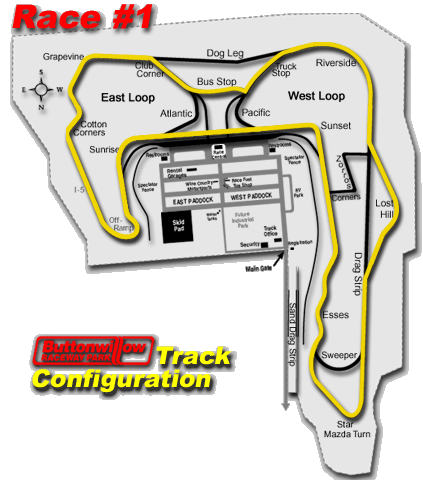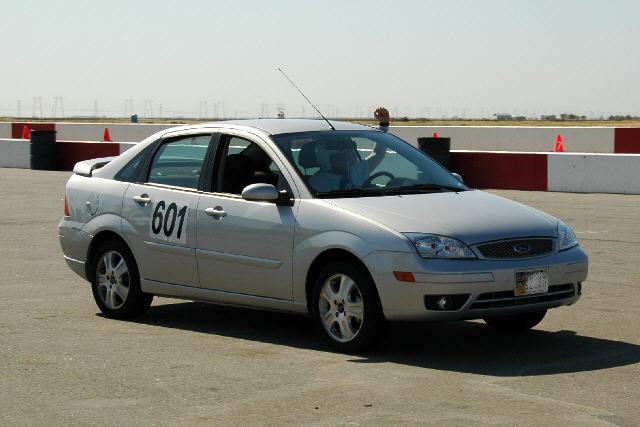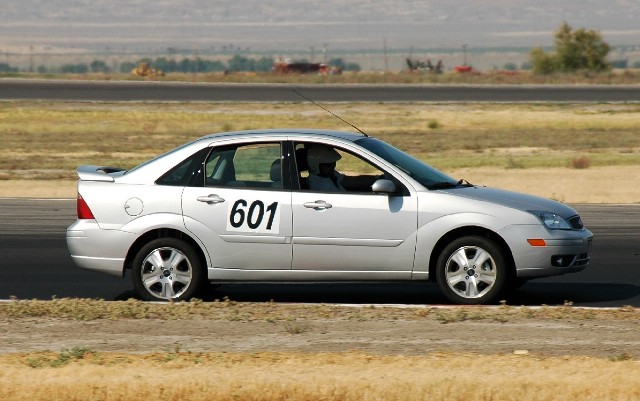Track Day #1- ZX4 ST @ Buttonwillow, CA
Ford Focus ZX4 ST - Track Day 1 - Phil Usher - June 2006
Last weekend
(June 9/10) I attended nasaproracing’s event at California’s
Buttonwillow Raceway in the capacity of HPDE (High Performance Driving
Education) instructor. If you have never attended an HPDE event I
highly recommend it. It’s the only safe way to explore your skill and
assess the true performance of your car. 
Learn more about HPDE at http://www.nasaproracing.com/hpde/index.html
Buttonwillow Raceway is located just outside Bakersfield at the Lerdo Hwy exit on off the Interstate 5 freeway. Getting to Buttonwillow from Las Vegas is a journey of about 350 miles and represented my first long run in the Focus. At 2:30pm Friday I departed a very windy Las Vegas and headed down the I15 freeway; I even managed to stay in my lane which is more than can be said for the California SUV brigade. The miles ticked by and despite 100+ temps there were no signs of overheating even while stuck in traffic while the fire service sprayed down a burning truck. The relatively small fuel tank means I needed to refill once along the way and it was about 7pm when I checked into Motel 6 at Buttonwillow.
Saturday morning I needed to be at the track by 7:30am for an instructors meeting but strangely I was already awake at 5:30. I opted get some breakfast at the local Denny’s which is a typical eatery for those heading to the track and it came as no surprise to find several people I know already present. After some banter and jibing all agree that it should be interesting to see how the Focus will perform on track. I recall leaving Dennys considering what I should expect and fearing what problems the Focus may present?
Focus performance at the Track: Fears and
expectations
-
Slow: I might not be fast enough to run in group 3. A very slow car is sometimes referred to as a “moving chicane” – Not something I want to be.
-
Tires: All weather tires might be a problem: Quickly become greasy, wear badly, and respond poorly to heat cycling or perhaps even chunk (loose bits of tread).
-
Suspension: The car might roll over so far as to produce rubbing of tires or have some unpleasant characteristics when on the bump stops.
-
Brakes: The brakes might prove inadequate, demonstrate excessive pad wear, score or warp rotors, boil the fluid or become excessively spongy.
-
Comfort: Drivers seat might not provide enough support to keep my body anchored and thus be a distraction.
-
Handling/Transitions: The car might prove very difficult to transition through a series of fast turns (think slalom).
Modifications in place on Track Day #1
-
Pedals.
-
Cosworth Cold Air Intake.
-
SCT (Hypnotic) Engine Tune + NRP adjustments.
-
141hp (at wheels)
Focus performance at the Track: Results Score Card (points out of 10)
-
Engine Power: 4
-
Grip: 5
-
Brakes: 7
-
Suspension: 8
-
Comfort: 9
-
Handling/Transitions: 6
-
Maintenance: 10
The Focus was well balanced. Nothing broke and the power and grip limited speed such that the brakes, suspension and comfort are good. As the car is modified this balance will change, the trick will be to make sure that changes in one area are not so radical as to induce catastrophic failure in another.
In more detail
Engine Power
Shear grunt from the lump was pretty absent above 85 mph. The car’s weight is a major factor here and if this were a race car I would be removing stuff rather than adding power. Reducing weight is preferable as it improves not only acceleration but also load on brakes and speed of transitions. However, this is my daily driver so the seats, trim and even most of the noise suppression stuff will stay and I’ll add power and eat the consequences.
One of the fortunate aspects to this weekend was that several of my fellow instructors were also driving “near” stock cars. Given the instructors are generally pretty good drivers this allowed some comparison. In particular the Focus performance appeared very much the same as a Scion TC, to properly verify this I should have swapped vehicles but that didn’t occur to me until I started writing this report.
Power is the area I shall work on. Exhaust system and higher lift cams are the changes I will make here.
Grip
The Pirelli all-season tires were unexpectedly good. No chunking, no melting, no tread flutter, no ill effects from heat cycling. Predicable and not prone to squealing without cause I find myself impressed by this unexpected match of Italian rubber with a baby Ford. Someone asked “How you like them all-season tires?” and was shocked by my answer; “45 laps and no sign of wear or damage, what’s not to like?”
Tires suitable for both track and daily driving really don’t exist. For the track (dry conditions) you want a soft compound that melts down to something that looks (to the inexperienced as) destroyed. In truth track tires are not done until they’re corded, flat-spotted or have been heat cycled so often as to have become the rubber equivalent of tempered steel. Road Tires have lots of tread will last 50,000 miles and are generally good for use in any conditions. Trying to select something which can be used for both (track and street) is a fool’s errand which is why most serious open-track guys bring along a second set of wheels (and tires) which they put on their car at the track. Carrying wheels, tools, jack and all the rest of that stuff to the track is something I wish to avoid with the Focus.
Grip is a future problem which I am unsure how to tackle. I had hoped that my Sentra Race wheels and tires might fit but this now seems unlikely. Oh well!
Brakes
I was really impressed with the brakes. Relatively small with single piston calipers and “who knows” brake fluid I expected all sorts of problems. Yes, there was some fade and a little sponginess but onset was gentle and backing off the pace provided fairly rapid relief. There is evidence of wear on the rotors and I haven’t looked at the pads but the brakes are still working fine and smooth.
Brakes are often a problem at the track. Away from the track people with high performance cars rarely drive them hard for more than a couple of minutes and their brakes never really get hot. However, at the track they might do 10 laps without letting up (perhaps 150 hard braking maneuvers) and come into the pits with their brakes smoking. Another common problem is coming in with hot brakes and sitting stationary with the brakes on; this places the pad on the hot rotor at specific spot, this spot doesn’t cool at the same rate as the rest of the rotor (think warp) or the pad material transfers more at this spot than elsewhere (think hard spot). This transfer problem can occur on track when someone locks up their brakes and goes off track; few have the presence of mind to let off the brakes after they stop. Finally people come into the pits and pull the hand brake, better to leave it in gear and turn off the engine (unless a turbo in which case use wheel chucks so you can leave the engine running for a bit).
Brakes are not yet a problem.
Suspension
There was no rubbing or any other indication that the suspension design was not up to being used on the track. Moreover, the stock suspension was predictable and while it may have a good deal of travel didn’t prove to be limiting. On occasions where I caught more curb than I intended the suspension simply absorbed it! Race track curbing has a smooth lip which generally will not bend a wheel and using the curbs through the “S” bends became something I would do to keep up with the faster cars. (See Handling/Transitions)
I feel no rush to make suspension changes.
Comfort
The wonderful thing about driving a street car at the track is comfort. Race cars are not comfortable, they’re hard to get in and out of, have hard movement constricting seats, uncomfortable belts, no air conditioning, no CD player and on top of that you have to wear all sorts of fire gear – nope race cars aren’t comfortable. Going to grid in a street car in 100 degree heat is delightful; air-conditioning, music, comfortable seats – Bliss. Prior to going on track the front windows are lowered (so the safety workers can pull you out without breaking the glass) and the A/C is turned off (A/C is now provided by the wind blowing through the open windows but only works above 100mph).
The Focus was very comfortable on track, the seats providing body support such that I wasn’t required to fight to keep my bum and upper body in the seat during turns. I once owned an Audi S4 with wonderful leather seats upon which my bum would slide around.
Arm Rest. I have previously described the Arm Rest as a floating morass of human insensitivity but I find myself only infrequently making contact with it. At the track I never hit it at all; this is probably because I moved the seat forward slightly.
I think it will be some time before I find myself in need of a harness or anything else for track comfort.
Handling/Transitions
The Focus as provided from the factory is designed to deal with pot holes, ridges and other road surface inconsistencies generally found on the public road system. I live in Las Vegas where no good road is left unpunished by roadwork so I like that the Focus can absorb these horrors. Ford has tuned the suspension to provide more independent wheel travel such that for example the left front wheel can traverse in and out of a hole without any drama.
Conversely a go-kart is designed for use on smooth surfaces and the suspension is much stiffer. Drive the go-kart’s left front wheel through a hole and the whole go-kart will bounce and probably jump to one side (drama). On the other hand a go-kart racer will point out that she can change direction so fast that she would simply drive around the hole.
With a go-kart there is so little suspension travel that when the steering wheel is turned weight is transferred immediately. With the Focus weight transfers much more slowly and it’s necessary to plan ahead and allow the weight to transfer before you’re in the turn. This is called allowing the car to “take a set” and if you don’t allow for it then weight might transfer while you’re in the turn and may overwhelm the maximum lateral grip level of your tires causing you to slide (read fall off track and become one with the scenery). The steering wheel is not the only means of inducing a transition either, brake and throttle also transition weight and all weight transfers need to be gradual and planned.
For comparison; transitions are slow for the focus when compared to a go-kart but quite quick if compared with my F250 truck. In practical terms the slow speed of transition only becomes a problem if a track demands rapid changes in direction like through a series of “S” bends.
In the Focus I found that as I tried to go faster through the “S” bends I couldn’t transition quickly enough and started falling behind my turn-in requirements. However, given the extra travel available I discovered that I could straighten out the bends by simply driving over the curbs!!
While “curb bouncing” was enough to allow me to keep pace at Buttonwillow faster transitions are valuable elsewhere; An emergency lane change on a freeway or an overtake on a two lane highway also will benefit from faster transitions. So, in the long run some investment to improve transition speed will be needed, only not yet.
Maintenance
I drove the car 350 miles to the track, ran ~50 laps and drove 350 miles home – no issues. The only maintenance was a need to tighten the lug nuts on the wheel which was removed to install the CAI – I guess we didn’t toque down the lugs properly.
As for post track maintenance - I need to find something to remove the rubber marks off the paint work. At the track the racecars use a soft compound tire which is transferred onto the track, accumulates into balls and is then thrown up by those in front of you. These balls of rubber bounce of your hood and windshield; they don’t do any damage but they leave behind little back marks. I saw someone at the track had made a “bra” from plastic shrink wrap – Providing you don’t cover the vents this seems like an effective means of defending paintwork but not one I think I’ll bother with myself.
The Focus is a hardy little car requiring very little maintenance and my changes thus far have not changed this desirable trait.
Conclusion
The Focus was a pleasant surprise; Predictable and reliable the current “near stock” package allowed me to approach boundaries without fear of damage.
While underpowered (above 85mph) I was quite pleased with the performance. Many at the track remarked how surprised they were at the quickness and such praise was unexpected. Also unexpected were the number of people who approached me to “get a ride”. I heard one advertised the experience as “you wouldn’t believe how smooth that guy is, you’ll need to check the speed and take notice of what cars you pass to recognize how fast you’re going.” While I take a certain pride in the smoothness of my transitions such smoothness is only possible with a consistent vehicle and the Focus is considerably more consistent than anything else I have driven on track in recent memory.
I think I’ll be at Willow Springs next month. Willow Springs is a high speed track with only nine turns which are easy to learn yet impossible to master. I don’t expect the Focus will be well suited to the course which features three very fast sweeping 4th gear right turns that may prove too much for the front left tire.
Return to Focus Page